
In a previous article on the Ruger SR1911 in 10 mm, I stated that if I was to carry the 10mm Auto cartridge, the Ruger SR1911 in 10mm Auto would be the pistol to carry it in. I must retract that statement, although the Ruger SR1911 10mm Auto is an excellent pistol and would be worthy of carry. While the Ruger SR1911 in 10mm Auto is an excellent pistol, and I would have full confidence in it and the cartridge, another option has reared its head, the Kimber Camp Guard 10.
While the Kimber Stainless Target Long Slide 1911 Pistol 6″ Barrel Stainless Steel is very enticing, and if I hunted it would be more than enticing, the 5” barrel of the Kimber Camp Guard 10; however, is more conducive to carrying IWB in environments where concealed means concealed and detection of a PDF (Personal Defense Firearm) is not wanted. It also has several features that are desired for defensive carry.
First, let’s take a look at some specifications for the Kimber Camp Guard 10, which is a pistol that is considered a “Special Edition” from Kimber:
Specifications
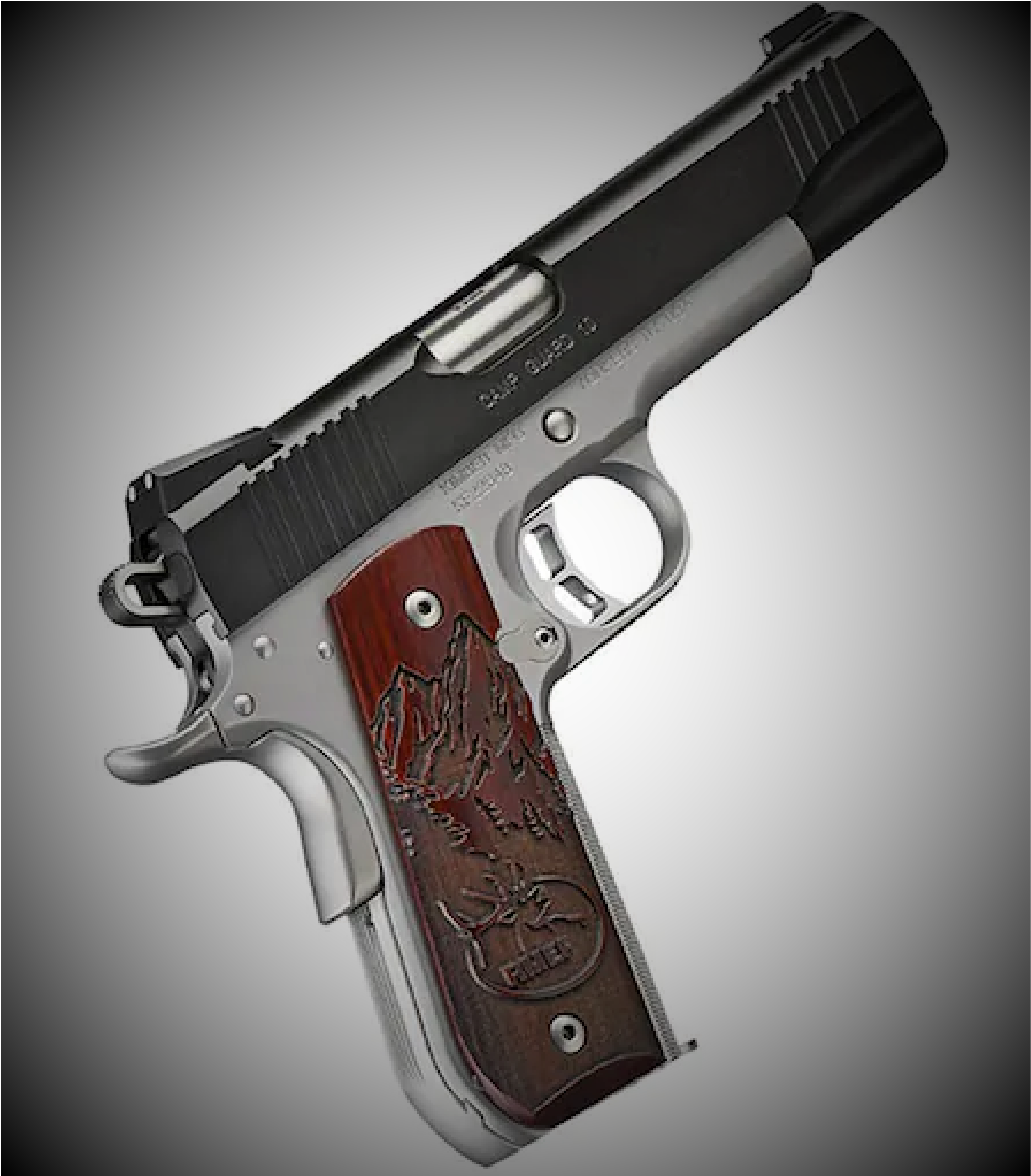
| Cartridge | 10mm Auto |
| Capacity | 8+1 Round |
| Weight | 38 Ounce |
| Barrel Length | 5 Inches |
| Action Type | Semi-Automatic |
| Trigger Type | Single Action |
| Safety | Thumb/Grip |
| Threaded Muzzle | No |
| Barrel Finish | Stainless |
| Front Sight | Night Sight |
| Rear Sight | Night Sight |
| Frame Material | Stainless Steel |
| Grip Material | Wood |
| Frame Finish | Stainless |
| Country of Origin | United States of America |
| Trigger Pull | 4-5 Pound |
| Compensated | No |
| Grip Color | Rosewood |
| Grip Style | Engraved |
| Slide Finish | Kimber’s propriety corrosion-inhibiting KimPro II finish |
The Kimber Camp Guard 10 has many features that distinguish it from other 10mm Auto 1911-based pistols.
“Designed in collaboration with RMEF for use in the backcountry, the Kimber Camp Guard 10 is a comfortable-to-carry handgun that combines sought-after personal defense features with the stopping power required for the largest of predators. Kimber is a proud sponsor of Rocky Mountain Elk Foundation. Wilderness weather can be brutal, but the Camp Guard 10 shrugs it off. It’s made of stainless steel, and the slide is coated with Kimber’s propriety corrosion inhibiting KimPro II finish. The sights are glow-in-the-dark tritium that is essential for the backcountry.” – Source: Kimber
The major selling points, for me, is the stainless-steel barrel, slide, and frame. Not that I am intending on carrying it in the backwoods of Georgia, I am just a sucker for stainless steel. And for a firearm intended to be carried IWB just behind my right hip or in a shoulder holster, having a stainless-steel slide in a corrosion inhibiting KimPro II finish, helps to keep the pistol undetected and further protected.
Throw in a set of low profile, drift adjustable for windage Tritium night sights for low-level lighting to sweeten the pot and a round butt to aid in concealment, and you have a near perfect carry 1911.
The now standard “Commander” hammer extended left-side only thumb safety, and nicely beaver-tailed grip safety with memory bump make for an excellent package. All controls are well-blended into the satin-finished stainless-steel frame. While I am not a fan of two-tone pistols, the Kimber Camp Guard 10 pistol is one good-looking 1911.
At 2 pounds and 6 ounces dry (38 ounces), and adding another 7.8 ounces for a full (8 round) magazine + 1, the Kimber Camp Guard 10 is no slouch in the weight department, but the weight is a big plus when shooting a 10mm Auto cartridge out of the 5” stainless-steel barrel.
Front and rear serrations afford an excellent hold when moving the slide to the rear.
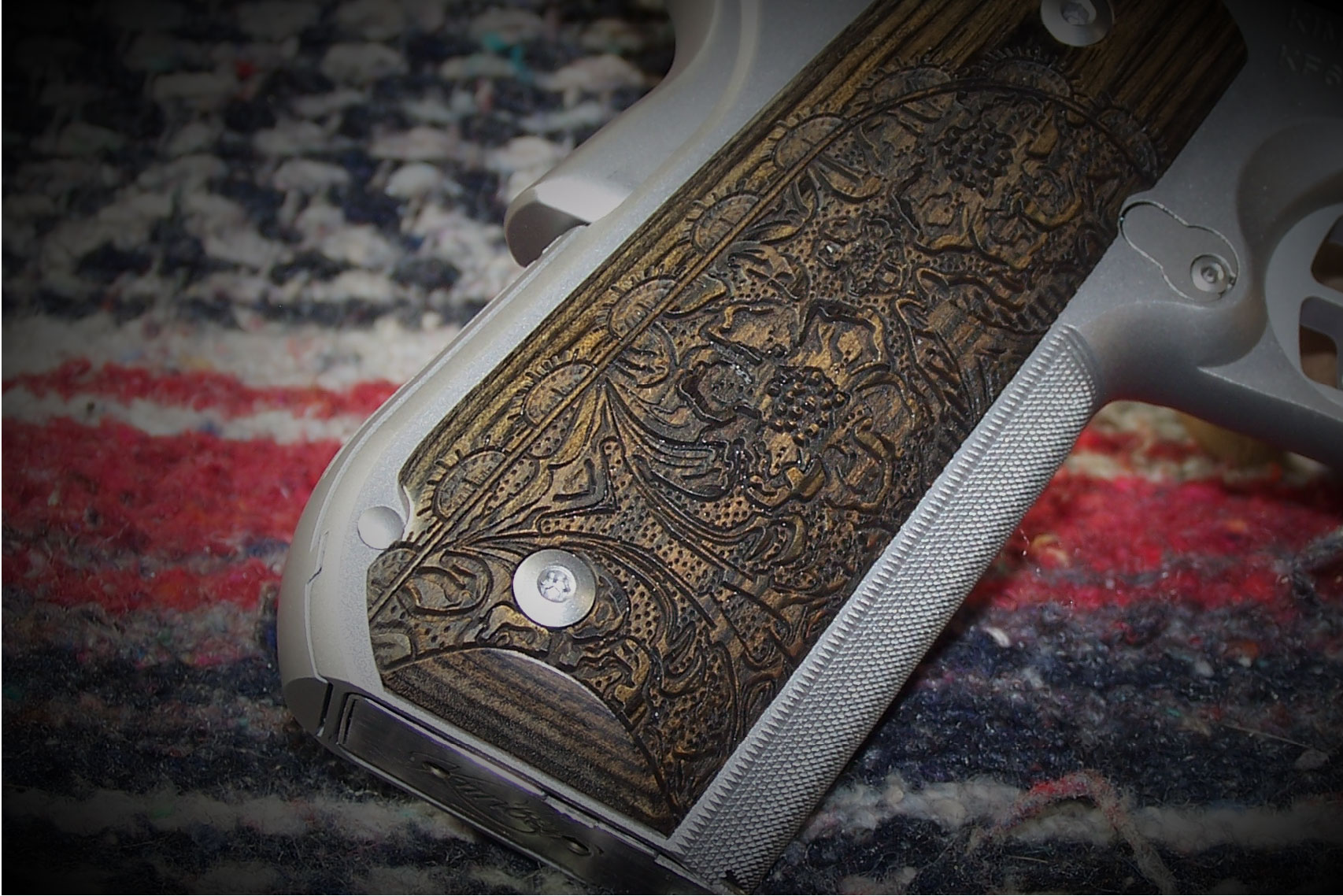
The grip, although rounded, feels to me like more of an M1911A1 with the arched mainspring housing. Rather than a flat mainspring housing, the mainspring housing has a slight arch to it.

Now for a thought about “round butts” or “bobtails.” They are here to stay and have been around for a while. They do carry much better than a square butt. For someone who carries IWB every day, it is a noticeable improvement, and being able to shoot them the same as a traditional butt, is a plus. I love the look of both, traditional and bobtail. There is room in the 1911 world for both, and we can thank Ed Brown for taking the lead. Click here for some reading material regarding “bobtail’ 1911 pistols.
This is the first round-butt 1911 that I have owned, although I have handled a few and argued with myself the pros and cons of such. The mainspring housing, although metal and vertically serrated, is not well-textured as compared with many 1911 pistols. However, the lack of mainspring housing texture works with this pistol, as the 30 lines-per-inch front strap checkering takes care of the grip factor.
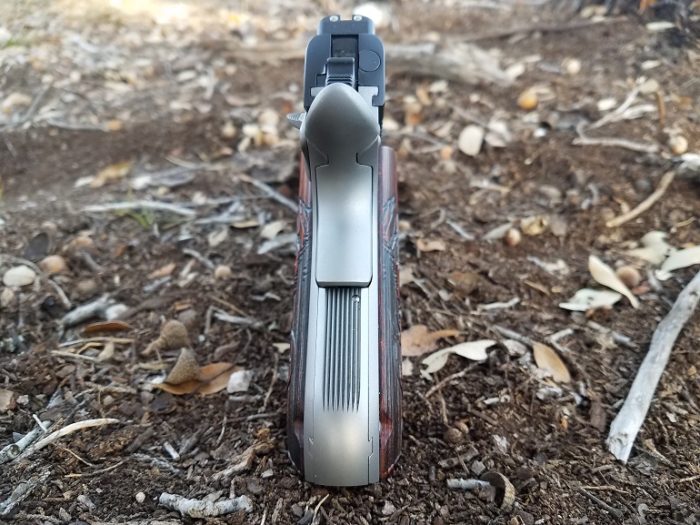
It should be obvious that the Kimber quality is in place and this can be observed externally and internally. All lines of the pistol are fluid and received the Kimber carry treatment. No snags or rough edges anywhere. The slide fit to frame is nearly seamless and nary a rattle is to be heard.
The Kimber Camp Guard 10 comes with one Kimber 8-round magazine and a search will be on for additional magazines. I have heard that Wilson Combat magazines work well in Kimber pistols and an investment in several of these is forthcoming. By comparison, the Kimber 10mm magazine is the same as the Ed Brown and Check Mate magazines. Theoretically, any 10mm aftermarket magazine should work; however, as with my Ruger SR1911 in 10mm Auto it still takes research into magazines to find ones that are 100% compatible and functional. Taking down a charging bear or a charging human, with both bent on your destruction, is no time for magazine failures or incompatibility with your chosen firearm.

Last but not least is that, through research, I found that the Kimber Camp Guard 10 has the best chamber support for the 10mm Auto cartridge, as compared to the Glock, Colt Delta Elite, Ruger SR1911, and the Para Ordinance (now the Remington R1 Hunter). When working with a high-pressure cartridge like the 10mm Auto , chamber support is a concern of mine. Click here to view the video.
Pre-Flight and Break-In
“Before firing the firearm for the first time, field strip and clean the firearm following proper procedures (see Disassembly, Cleaning and Lubrication and Assembly instructions in the manual). For proper break-in, fire 400-500 rounds of 230 grain (or heavier) full metal jacket, high quality factory-fresh premium personal defense ammunition. Clean and lubricate the firearm after every 100 rounds or after each shooting session, whichever is first, or more often as needed, such as when the firearm is exposed to dirt, moisture or perspiration.” – Source: Kimber
I have to say that the Kimber Camp Guard 10 is one of the tightest fitting 1911-based pistols that I have had the pleasure to disassemble and assemble. Kimber provides a bushing wrench and you will absolutely need it. Even locating the disassembly notch to the slide stop is a challenge because of the tight tolerances.
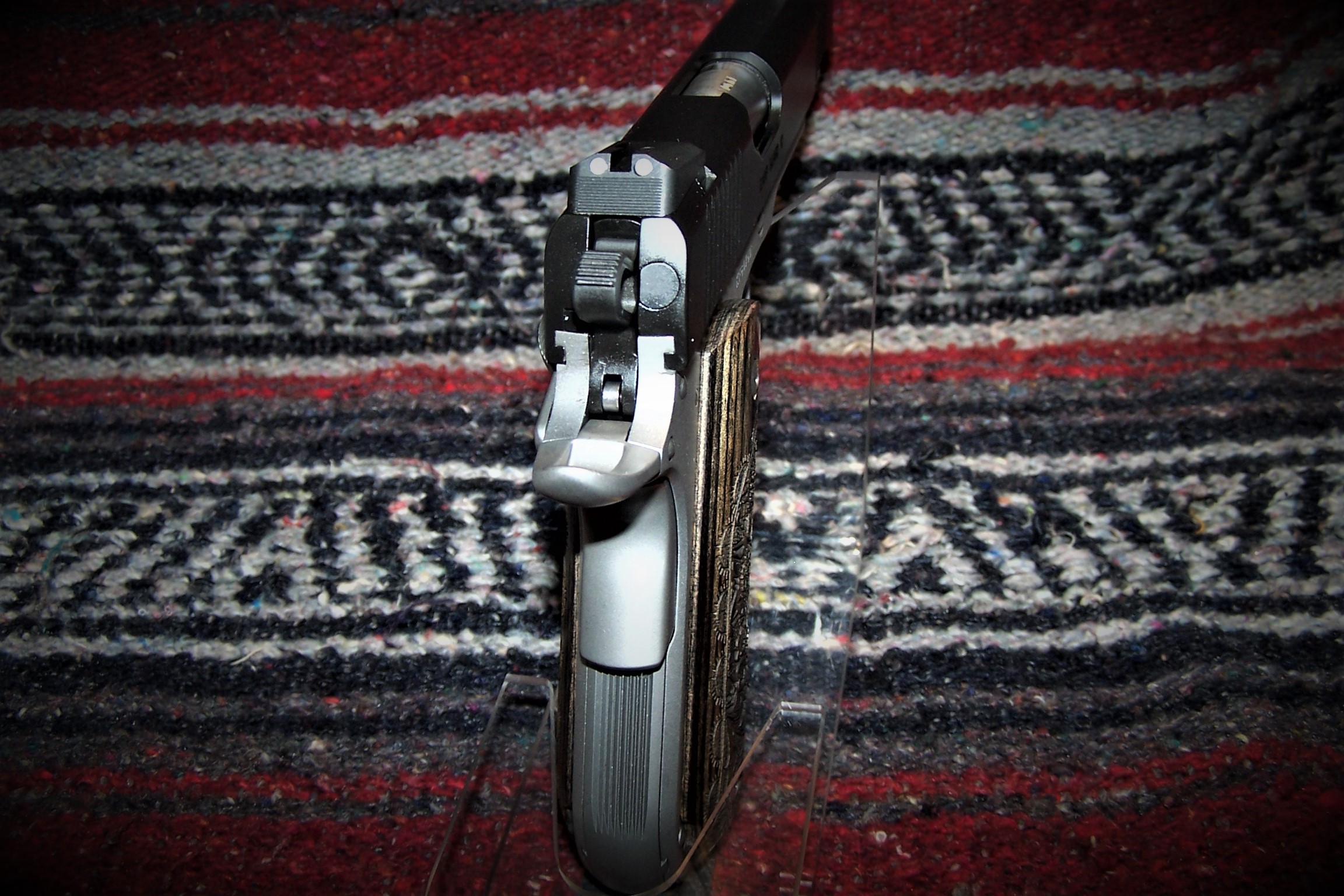
Upon disassembly, the barrel must be slid forward to alleviate the tension between the barrel bushing and the barrel. The barrel bushing to slide fit is also very tight.
Once disassembled, the first thing that you will notice is the machine work, and to me it looks absolutely flawless.
There is no doubt in my mind that the Kimber Camp Guard 10 is a pistol built to exacting standards of quality and precision. I have other Kimber 1911 pistols that I have yet to review. If the quality of these pistols is as high as the Kimber Camp Guard 10, I can see why Kimber is a ‘top-drawer’ leader in building production-level 1911 pistols.
The Kimber Camp Guard 10 reflects “70 Series” Colt 1911 pistols with no firing pin block safety, but it uses a traditional solid barrel bushing rather than a Collette barrel bushing as found in “70 Series” Colt 1911 pistols.
The Kimber Camp Guard 10 is not a pistol that I would run without adequate, if not judicious, lubrication. This pistol is not a Glock where a “little dab will do ya’.”
RANGE TIME
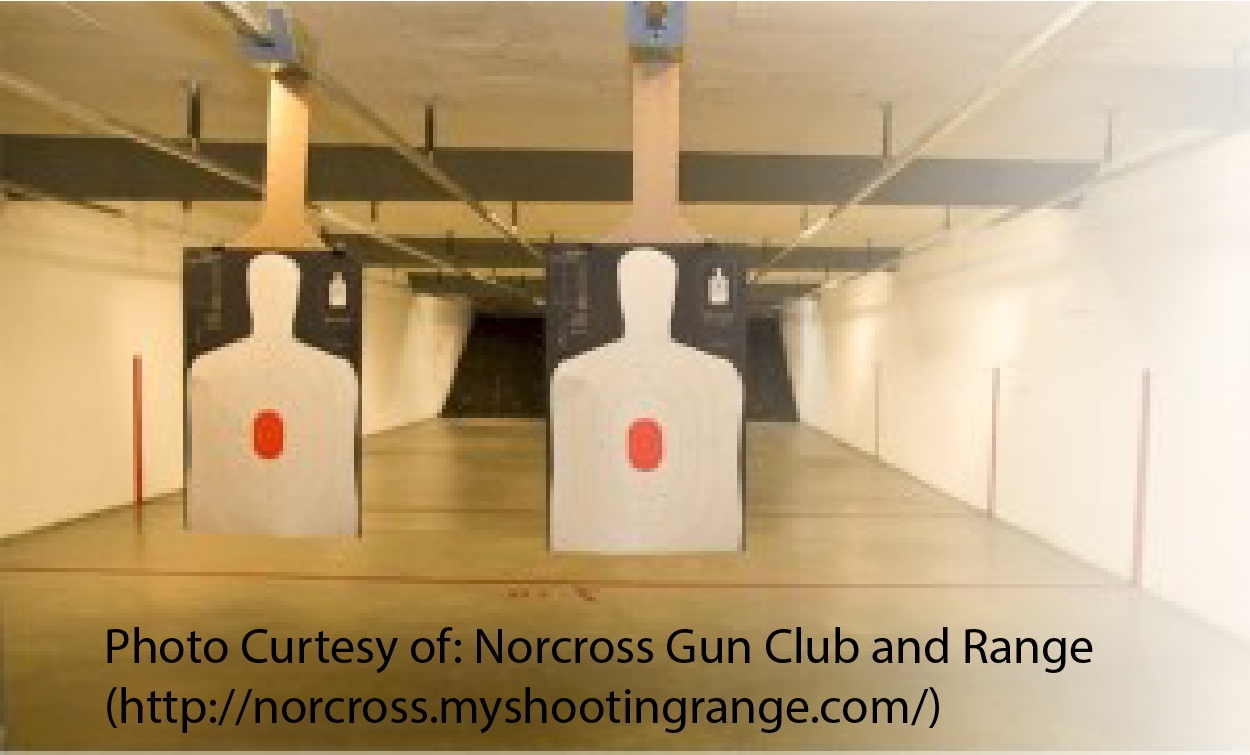
Range day finds me with my usual fare; Sellior & Bellot 180-grain FMJ for function testing and some Sig Sauer V-Crown 180-grain JHP for defensive load testing.
The first outing with the Kimber Camp Guard 10 was both frustrating and satisfying. Satisfying from the fat that the Kimber Camp Guard 10 is extremely accurate. Frustrating from the fact that FTF issues with the pistol tried my patience.
While I had the one Kimber-provided 8-round magazine, I supplemented this with a couple of Wilson Combat, Mec-Gar, and Metalform magazines from my Ruger SR1911 outings.
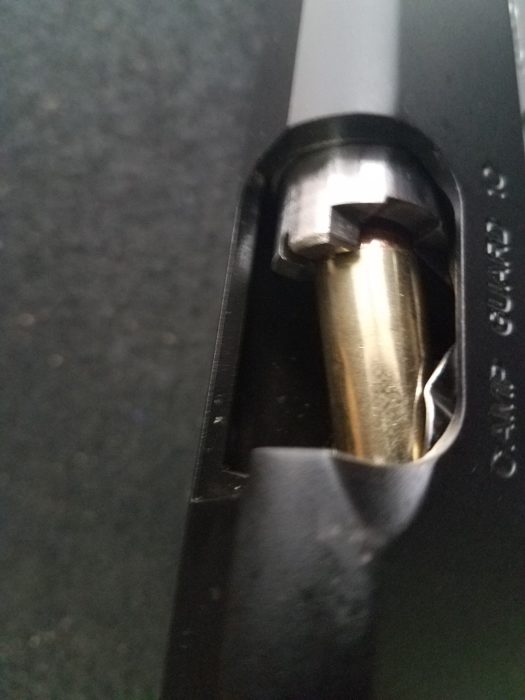
Unfortunately, FTF issues reared its ugly head on the first round. If you have read my review of the Ruger SR1911 10mm (and why have you not?), you know that FTFs were a common issue with that pistol. The tighter tolerances of the Kimber Camp Guard 10 magnified the FTF issue starting with the provided Kimber magazine. No matter the method of chambering a cartridge (pressing the slide release lever or using the ‘sling shot’ method) would chamber a round. At first, every round would jam in the chamber, which resulted in me dropping the magazine and using a tool to press upward on the case until the cartridge would free up. I would then push the round into the chamber and release the slide. This went on for some time. At about seventy-five rounds things started loosening up a bit. By the end of one-hundred rounds, there were no FTFs using three magazines. One new Metal-Form magazine and a Wilson Combat magazine failed repeatedly. While frustrating and taxing my patience, I understood that this was part of the break-in. But, when the Kimber Camp Guard 10 ran without failure, oh my! While all the FTFs were distracting, the accuracy of the pistol leaves nothing to be desired. The night sights are spot on at combat distance…place the sights just below what you want to hit, and you will hit the mark, if you do your part.
I can say that I have had less feeding issues with 9mm and .45 ACP 1911 pistols as compared to the 10mm Auto versions of the 1911. The Springfield XDM 5.25 in 10mm Auto spoiled me, as it ran 100% out of the gate, as I am sure than any Glock 10mm Auto would be the same. But, a high-quality 1911 is more of a precision instrument and the satisfaction of shooting them when they are fully functional is highly satisfying and worth the toil…the price of admission is worth the show.
At thirty-eight ounces (dry), the Camp Guard 10 is lighter than the Ruger SR1911 10mm Auto at 40.4 ounces, but I cannot tell a pronounced difference in felt recoil when shooting the same ammunition out of both pistols. Felt recoil is sharp and to the point, but highly manageable when using a good firm grip.
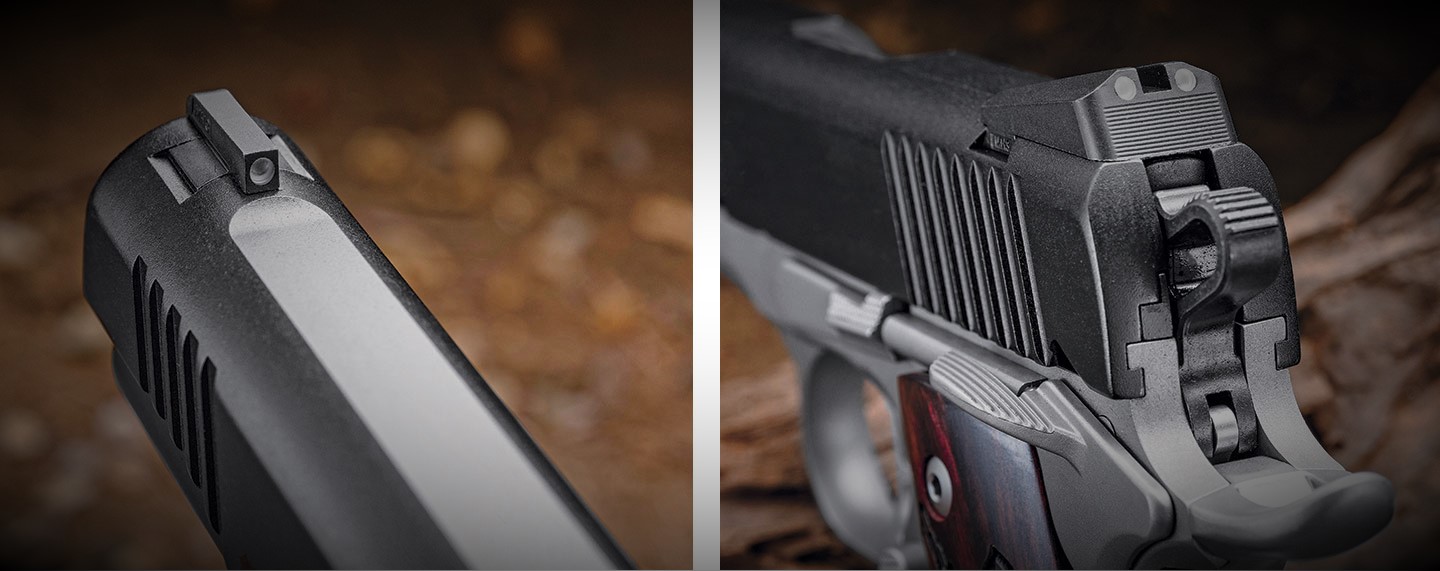
I will definitely say that I prefer the night sights of the Kimber Camp Guard 10 over the target sights of the Ruger SR1911. The night sights are easy to pick up even with my older eyes. Not so much with the target sights of the Ruger SR1911.
The extended thumb safety operates very well when moving position to position and the feel of the safety is the same in both directions. The slide lock can take some effort to work, but will work in as the pistol breaks in. Using the ‘sling shot’ method to chamber a cartridge takes some strength in overcoming the 18.5-pound recoil spring but hearing that familiar ‘Ka chunk’ when the round chambers is most satisfying. In this case, I wasn’t getting past the ‘Ka’ to get to the ‘chunk’ part until late in the shooting session.
With the intent of carrying the Kimber Camp Guard 10, and although shooting at 7 yards for function and accuracy was sufficient for me to believe that the Kimber Camp Guard 10 excels in both areas, I wanted to run my “Hallway Drill” that is a combination of a “Mozambique Drill” run two-handed and one-handed (strong and weak) shooting with a reload; however, due to the number of FTFs, the “Hallway Drill” had to be put off. I have, for your reading enjoyment, included the “Hallway Drill” below in case you are interested.
The drill can start one either side, left or right. For this session, I started from the right side in a bladed one-hand stance with the back against the wall, two center mass shots are taken with a follow-up shot to the head. I then move into a crouched Isosceles two-handed stance where two center mass shots with a follow-up to the head is taken. The pistol is then passed to the weak hand (my left, in this case), where the remaining two rounds are placed center mass. A weak hand “combat Reload” is performed. Once complete, one round to the head is shot. The next step is to move out of the crouched Isosceles two-handed stance into a weak-side one-handed bladed stance with the back against the left wall. Two center mass shots with a follow-up to the head is taken. That leaves me with four shots remaining, one in the pipe and three in the magazine. This completes the first phase of the routine.
The second phase of the routine picks up where I left off. Two center mass shots and one head shot are taken before moving back into a crouched Isosceles two-handed stance; after which, one headshot is taken. At this point, the pistol is passed to the right (strong) hand and a reload is performed.
From the crouched Isosceles two-handed stance, two center mass shots followed up by a head shot is performed. The next transition takes us back to the beginning with the back against the wall and a bladed one-hand shooting position. Two more center mass with a head shot follow up is performed. To complete the exercise, I move back into the crouched Isosceles two-handed stance and perform a one center mass shot and one last head shot and complete the exercise. The pistol, at this point, is empty and the slide locked to the rear. This is an opportune time for another reload, and safe the pistol.
If I use an extended capacity (9-round) magazine, I simply adjust my point for a combat reload. Note that I perform this exercise without ‘topping off’ the pistol. I will say that working with a 9-round magazine does simplify things, as a three-shot string puts my reload during the crouched Isosceles two-handed stance.
This exercise is highly customizable to varying pistol capacity regardless of caliber. I have run it with revolvers and semi-autos. However, it is best to practice the routine with the pistol (or revolver) that you would normally use in a hallway-clearing scenario. In other words, whatever firearm you are going to grab in the middle of the night when responding to an event should be the firearm used in this drill.
(Author’s Note: A follow-up habit that I have developed over the years is if I have a spare, fully loaded magazine available, regardless of capacity or type of firearm (pistol, revolver, rifle, no matter), and no matter how many rounds are left in the magazine or cylinder, I do a ‘combat reload’ even after the threat has been neutralized and safe the firearm (safety on, if available, and finger off of the trigger). While this is not allowed in a competitive match, I do not train for competition and having a full magazine or cylinder gives me warm fuzzies.)
Now that I have strayed a bit, let me return to my regularly scheduled write-up.
This was the first outing for the Kimber Camp Guard 10 and was a bit more than a just a function and accuracy check. The 4-pound 13.6-ounce pound-trigger pull, with minimal travel and no over-travel (adjustable), on this particular pistol is just short of excellent with the trigger being quite responsive for a yet broken in pistol. Handling is superb, although I have to say that my weak-hand operating leaves quite a bit to be desired. But that is me and not the pistol.
Since this was day one of shooting the Kimber, several more days will follow until the break-in period is achieved, or when I am confident that the Kimber Camp Guard 10 will serve me without fail.
As a last note, the recoil caused all four grip panel screws to loosen slightly. You may want to add an O-ring to each screw, as I did, to prevent screw turn-out.
Carrying and Concealing
The beauty of carrying a 1911-based pistol is that virtually any holster made for a 1911 pistol will work, and I already have several. I think that I would be safe to say that you also have several yourself, if you are a 1911 enthusiast.
At my top spot (at least at this time) is the Falco A-112 Hawk IWB holster; a dual clip-on holster with the gripping tenacity of a hawk when in the waistband. In basic black or russet (shown below) with no sweat guard, this is a perfect holster for me to house the Kimber Camp Guard 10 (and other 1911 pistols of various calibers) and keep it away from prying eyes. With it , I have passed numerous detection tests in places where carry is not allowed and where concealed means concealed.
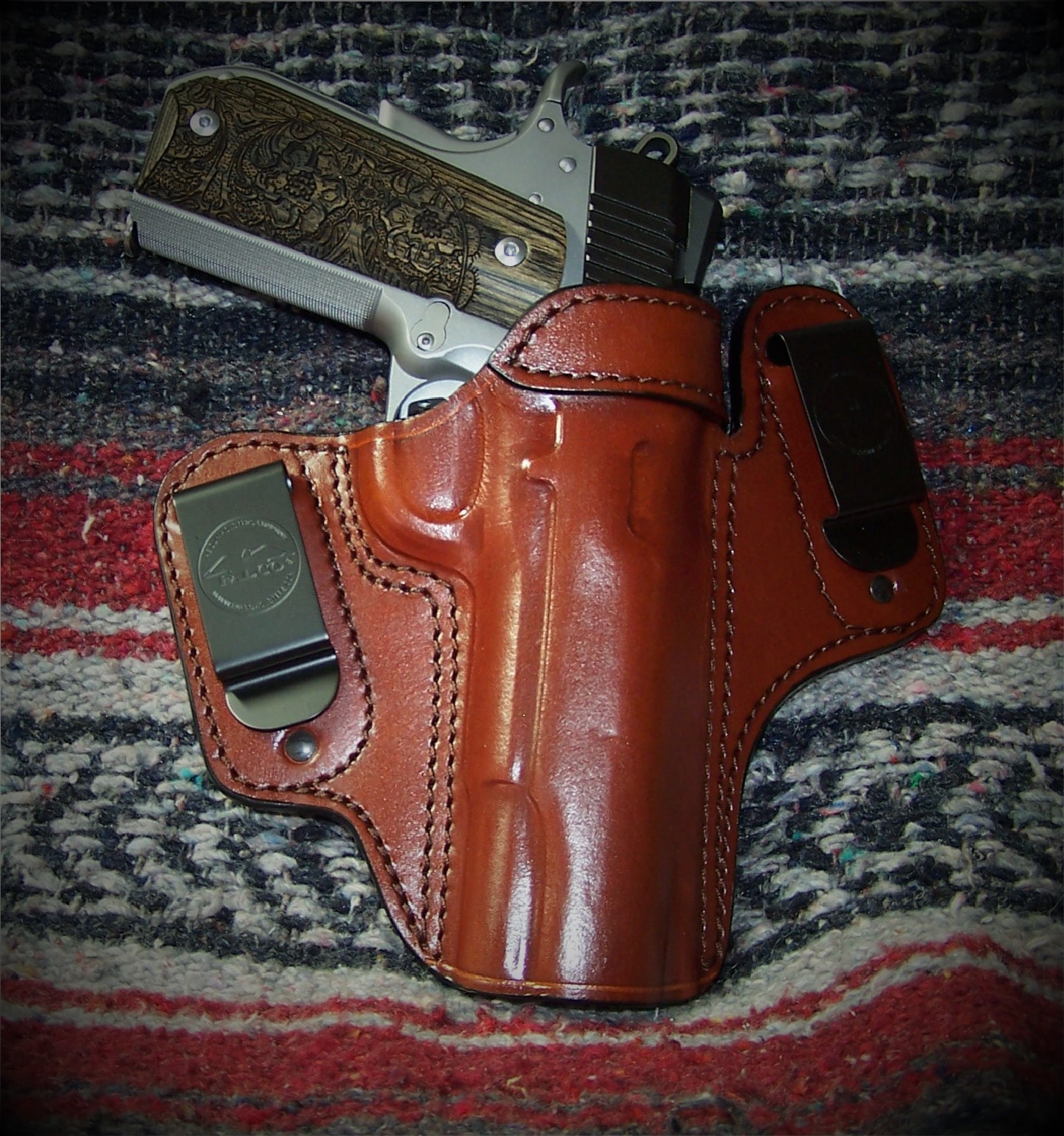
A second holster is my Savoy holster for the 1911; a full-bodied IWB dual-clip holster built for duty use. While this holster takes up some real estate, it is highly stable and comfortable but slightly bulky. It would be best used in cooler or colder weather when an overgarment is called for.
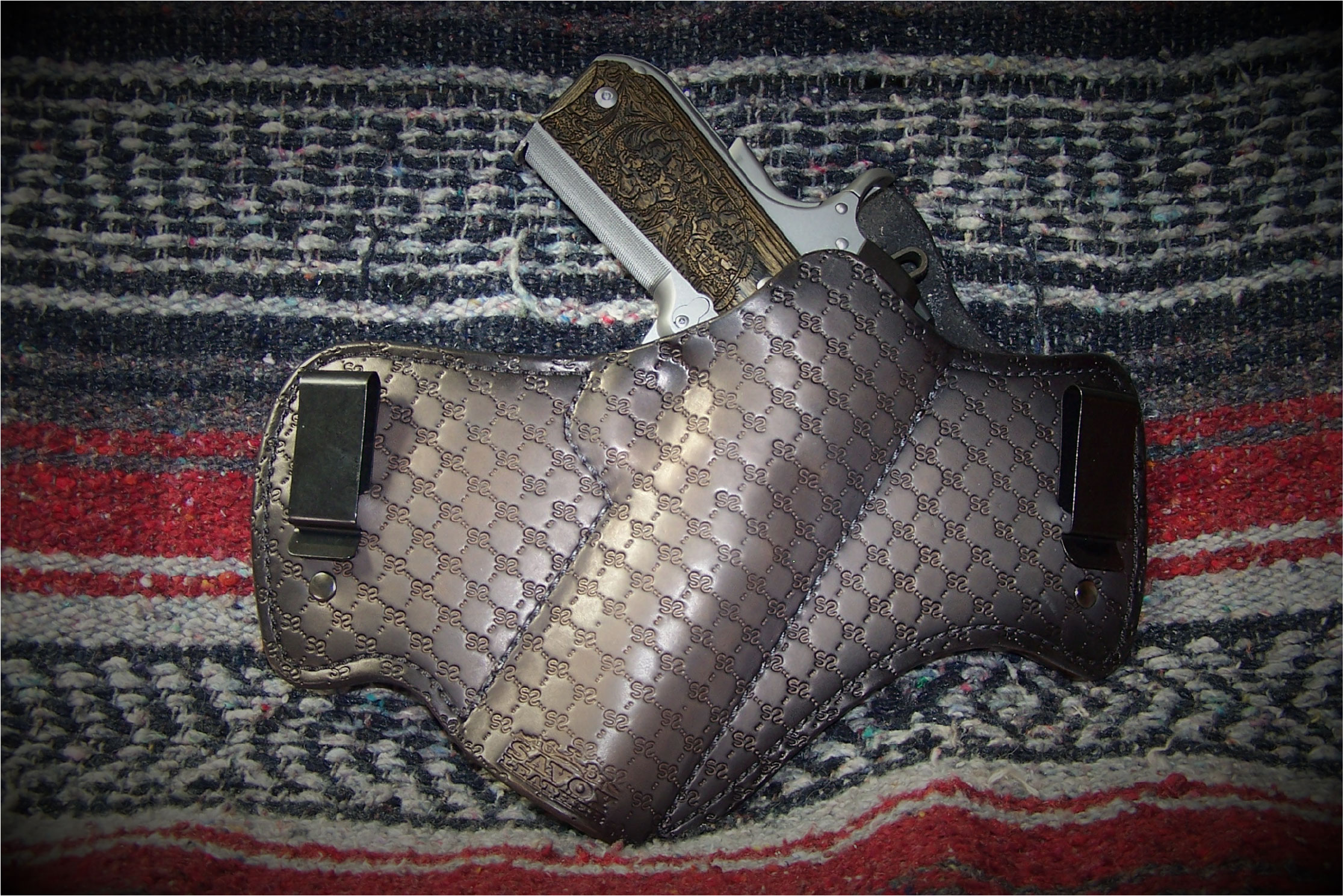
Many designs and colors are available. Each holster is custom-made, and the wait may be several months.
One of my favorite OWB holsters is a custom basket-weave holster by Leather Creek Holsters; a holster that I have worn on several occasions during wintry weather. Unfortunately, I do not have a good picture of the Leather Creek Holster, and just as unfortunate, Walt Sippel, the founder of Leather Creek Holsters has officially retired, and his fine handy work is no longer available except for the Ruger Bearcat. Fortunately, Reily Kester at Kester Farms Custom Gun Holsters and Tony Kim at Tactical Gun Leather come highly recommended by Walt and samples of their handywork can be seen at their websites. Of course, there are other holster manufacturers that may have holsters that fit your needs.
The one holster that you will not find housing the Kimber Camp Guard 10 is a “Kybrid,” although I have several for the 1911. The Kimber Camp Guard 10 is too nice of a 1911 to subject to the harsh environment of Kydex. My Rock Island Armory 1911 FS Tactical (and other RIA pistols) has been carried in a Black Arch IWB holster for quite some time and has developed the character of a firearm that has been carried, drawn, and inserted quite a few times in this “Kybrid” holster. I do not wish the same for my ‘finer’ 1911-based pistols.
Summary
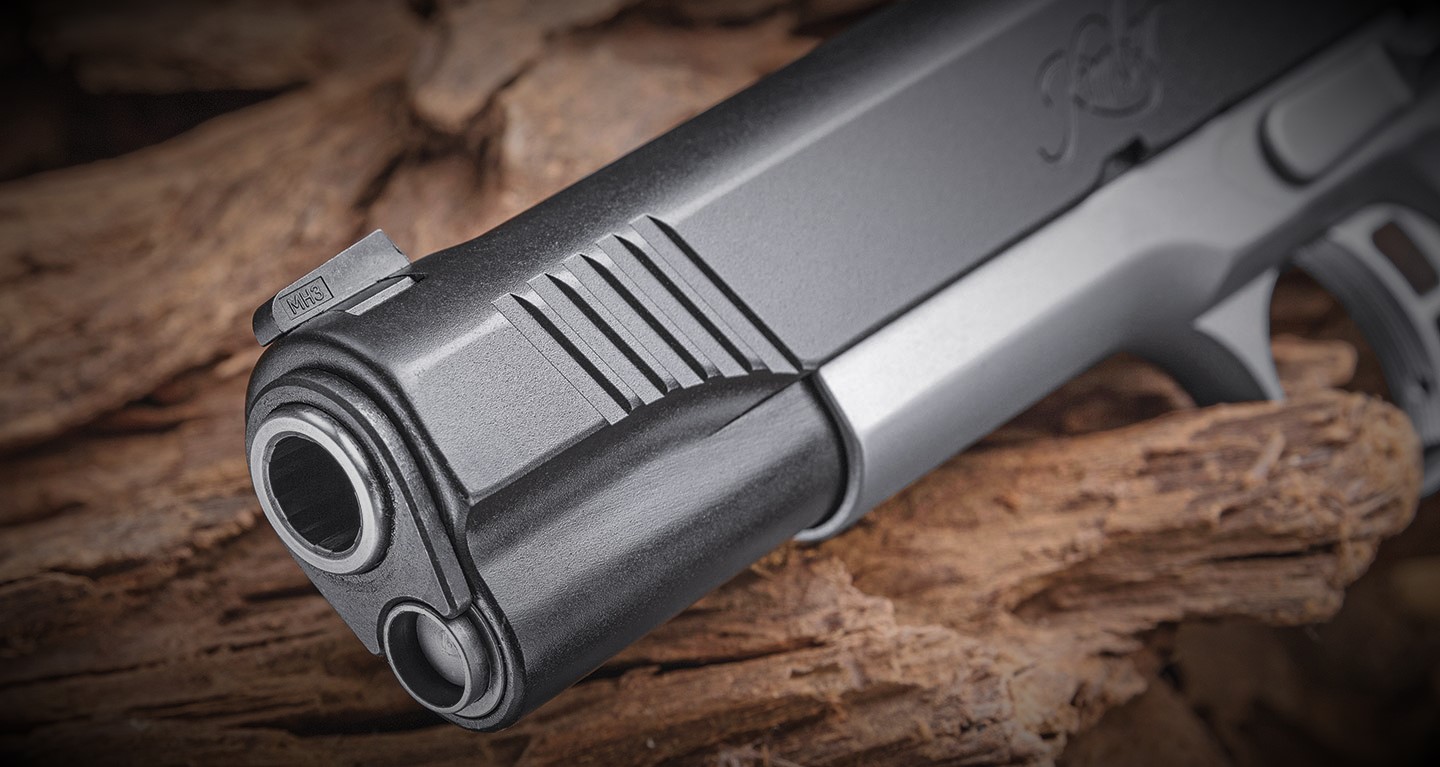
I am gaining a lot of respect for the 10mm Auto cartridge as a viable self-defense load due to the variety of bullet weights and power-loadings. For more than a century, the revolver has filled the role of a powerful firearm that can be used for hunting and self-defense from four-legged and two-legged animals, since most pistols are chambered in cartridges that, correctly or not, were deemed too weak for such a task. The 10mm Auto changed that equation, making duty-sized semi-auto handguns viable choices for carry whether in the back country or other settings. The Camp Guard 10mm Auto from Kimber is one such handgun, designed from top to bottom for a specific role. The Kimber Camp Guard 10 is the third and my final 10mm Auto pistol, and it is the second 1911-based 10mm Auto pistol with the Springfield XDM 5.25 10mm Auto being the oddball of the group.
Now for the bad and the ugly.
Because of the issues with FTFs with this pistol, and other things, I decided to modify this article and create a Part 2 to this article, which I address an upgrade and also walk you through the frustrating range days, improvements to prevent FTFs, and maybe some other aggravations. Continue to Part 2.
Resources
Kimber Camp Guard 10: https://www.youtube.com/watch?v=dV9c698pX4M
Kimber Camp Guard 10: https://www.kimberamerica.com/camp-guard
10MM Chamber Support-Colt Delta-SR1911-Para Hunter-Kimber Camp Guard: https://www.youtube.com/watch?v=F2AN5v7AjyI
Falco A-112 Hawk IWB Holster: https://www.falcoholsters.com/stable-easy-on-iwb-leather-holster-a112-hawk?variant=818
Savoy Holsters: https://www.savoyleather.com/product/in-the-waistband-conceal-carry-iwb/
![]()

